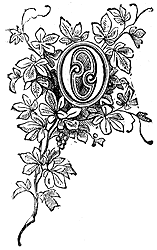 |

N the very brink of a tremendous precipice, 300 feet above the sea, is the ruined castle of King Arthur. It stands on the extremity of a bold headland, called by the people "the Island," because the rush of waters has nearly separated it from the mainland. The castle occupied originally both its present site and the opposite hill, the two portions being united by a noble bridge, the foundations of which are still visible. Arches and steps cut in the rock remain, and walls of different elevations inclose wide areas, which were once royal apartments, but are now carpeted with turf, and roofless. Here the mountam goat graces, and the children of the neighbourhood play.
Arthur was born in Tintagel, and kept his court in manhood here, at times, surrounded by his famous knights. Fuller gives us this quaint account of the King of British chivalry.
"King Arthur," he says, "son of Uther Pendragon, was born in Tintagel Castle, and proved afterwards monarch of Great Britain. He may fitly be termed the British Hercules in three respects : (1) for his doubtful birth; (2) painful life - one famous for his twelve labours, the other for his twelve victories against the Saxons, and both of them had been greater had they been made less, and the reports of them reduced within the compass of credibility. (3) Violent and woeful death: our Arthur's being as lamentable and more honourable, - not caused by feminine jealousy, but masculine treachery - being inurdured by Mordred near the place where he was born,-
"After the Conquest, Tintagel was trequently the residence of royalty. It was here that David, Prince of Wales, was splendidly feasted during his war with Henry III., in 1246."

Three centuries later, Leland speaks of it as "sore weather-beaten and in ruin."
The ruins of the ancient chapel on the island were investigated in 1860 by the Vicar of Tintagel.
"The chapel," says the Building News of Sept., 1860, "has been cleared, and the stone altar stands revealed in a perfect state, except that the slab (a ponderous block of granite) had been removed and was lying on the floor. This has been replaced. On either side of the altar is a grave lined with slate; but no bones were found in them.
That on the south side has a singular recess in it, constructed of granite, and intended apparently to allow of access by the hand to the interior of the vault, which may have been used as a receptacle for relics. The position of the chancel-screen is indicated by two recesses in the walls, north and south, from which it has been removed."
But the chapel must have been built very long after Arthur's time, for it is Transition Norman in character, and probably dates from the middle of the twelfth century.
The vicar has also effected considerable repairs of Tintagel Castle, and converted the old sheep-walk up the side of the "island" into a good path.
Near Camelford is the place where Arthur fell mortally wounded, and his treacherous nephew, Mordred, was also slain.
Here fell in that terrible battle the remaining Knights of the Round Table, dying with their lord - one only survived.
Sloven Bridge was anciently called Slaughter Bridge, because it was choked with dead by that fatal battle.
Boscastle is three miles from Tintagel, by a hilly road. To the left is a bold range of hills, said to have been the ancient boundary between the land of the Saxons and the Celts.
At Longbridge a stream is crossed, which about a mile inland falls over a steep rock, forty feet high, into St. Nectan's Keeve. A keeve is a basin; the bowl used by a miner in washing his tin-nuggets is called a keeve.
"There is another leap of about ten feet," says Mr. White, "and you may descend to it by returning to the outside of the rocks, scrambling down to their base, and along the narrow, slippery path leading into the chasm. Here you see an arch below the edge of the keeve, in which a flat slab having lodged, the water, broken as it shoots through, falls a thin, flickering curtain into the pool beneath. The best view is from the farther margin of the stream, and to cross on the gravelly shallow below the pool will scarcely wet more than your shoesoles. The effect is singularly pleasing. You are at the very bottom of the dell, in complete seclusion, with trees above on each side forming a screen that admits but a dim light; a glimpse of the upper fall through the arch, and the pretty noise of the falling water-no other sound audible save the occasional twittering of a bird. Retracing your steps, you see where the stream flows past the massive slab of slate rock lying in its bed, and disappears in the brake. Then up the damp, weedy path to the top of the bank, where stand the walls of a cottage, once the habitation of two recluse ladies who lived in it some years - a mystery to the neighbourhood - and died without revealing their secret."
|
 |